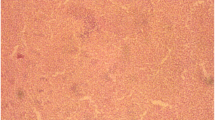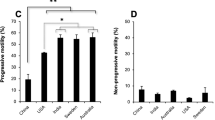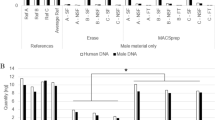Abstract
This study reports the development of a two-step protocol using pressure cycling technology (PCT) and alkaline lysis for differential extraction of DNA from mixtures of sperm and vaginal epithelial cells recovered from cotton swabs. In controlled experiments, in which equal quantities of sperm and female epithelial cells were added to cotton swabs, 5 min of pressure pulsing in the presence of 0.4 M NaOH resulted in 104 ± 6 % recovery of female epithelial DNA present on the swab. Following the pressure treatment, exposing the swabs to a second 5-min alkaline treatment at 95 °C without pressure resulted in the selective recovery of 69 ± 6 % of the sperm DNA. The recovery of the vaginal epithelia and sperm DNA was optimized by examining the effect of sodium hydroxide concentration, incubation temperature, and time. Following the alkaline lysis steps, the samples were neutralized with 2 M Tris (pH 7.5) and purified with phenol-chloroform-isoamyl alcohol to permit downstream analysis. The total processing time to remove both fractions from the swab was less than 20 min. Short tandem repeat (STR) analysis of these fractions obtained from PCT treatment and alkaline lysis generated clean profiles of female epithelial DNA and male sperm DNA for 1:1 mixtures of female and male cells and predominant male profiles for mixtures up to 5:1 female to male cells. By reducing the time and increasing the recovery of DNA from cotton swabs, this new method presents a novel and potentially useful procedure for forensic differential extractions.




Similar content being viewed by others
References
Baird M, Balazs I, Giusti A, Miyazaki L, Nicholas L, Wexler K, Kanter E, Glassberg J, Allen F, Rubinstein P, Sussman L (1986) Allele frequency distribution of two highly polymorphic DNA sequences in three ethnic groups and its application to the determination of paternity. Am J Hum Genet 39(4):489–501
Gill P, Jeffreys AJ, Werrett DJ (1985) Forensic application of DNA “fingerprints”. Nature 318(12):577–579
Jeffreys AJ, Wilson V, Thein SW (1984) Hypervariable ‘minisatellite’ regions in human DNA. Nature 314:67–73
Burger J, Hummel S, Herrmann B, Henke W (1999) DNA preservation: a microsatellite-DNA study on ancient skeletal remains. Electrophoresis 20(8):1722–1728
Fondevila M, Phillips C, Naverán N, Cerezo M, Rodríguez A, Calvo R, Fernández LM, Carracedo Á, Lareu MV (2008) Challenging DNA: assessment of a range of genotyping approaches for highly degraded forensic samples. Forensic Sci Int Genet 1(1):26–28
Raymond JJ, van Oorschot RA, Gunn PR, Walsh SJ, Roux C (2009) Trace evidence characteristics of DNA: a preliminary investigation of the persistence of DNA at crime scenes. Forensic Sci Int Genet 4(1):26–33
Norris JV, Manning K, Linke SJ, Ferrance JP, Landers JP (2007) Expedited, chemically enhanced sperm cell recovery from cotton swabs for rape kit analysis. J Forensic Sci 52(4):800–805
Vuichard S, Borer U, Bottinelli M, Cossu C, Malik N, Meier V, Gehrig C, Sulzer A, Morerod M, Castella V (2011) Differential DNA extraction of challenging simulated sexual assault samples: a Swiss collaborative study. Investig Genet 2(1):11
Voorhees JC, Ferrance JP, Landers JP (2006) Enhanced elution of sperm from cotton swabs via enzymatic digestion for rape kit analysis. J Forensic Sci 51(3):574–579
Benschop CCG, Wiebosch DC, Kloosterman AD, Sijen T (2010) Post-coital vaginal sampling with nylon flocked swabs improves DNA typing. Forensic Sci Int Genet 4:115–121
Elliot K, Hill DS, Lambert C, Burroughes TR, Gill P (2003) Use of laser microdissection greatly improves the recovery of DNA from sperm on microscope slides. Forensic Sci Int 137(1):28–36
Garvin AM, Fischer A, Schnee-Griese J, Jelinski A, Bottinelli M, Soldati G, Tubio M, Castella V, Monney N, Malik N, Madrid M (2012) Isolating DNA from sexual assault cases: a comparison of standard methods with a nuclease-based approach. Investig Genet. doi:10.1186/2041-2223-3-25
Horsman KM, Barker SLR, Ferrance JP, Forrest KA, Koen KA, Landers JP (2005) Separation of sperm and epithelial cells in a microfabricated device: potential application to forensic analysis of sexual assault evidence. Anal Chem 77(3):742–749
Hudlow WR, Buoncristiani MR (2012) Development of a rapid, 96-well alkaline based differential DNA extraction method for sexual assault evidence. Forensic Sci Int Genet 6(1):1–16
Schoell WM, Klintschar M, Mirhashemi R, Pertl B (1999) Separation of sperm and vaginal cells with flow cytometry for DNA typing after sexual assault. Obstet Gynecol 94(4):623–627
Schoell WM, Klintschar M, Mirhashemi R, Strunk D, Giuliani A, Bogensberger G, Pertl B (1999) Separation of sperm and vaginal cells based on ploidy, MHC class I-, CD45-, and cytokeratin expression for enhancement of DNA typing after sexual assault. Cytometry 36(4):319–323
Weigand P, Schurenkamp M, Schutte U (1992) DNA extraction from mixtures of body fluid using mild preferential lysis. Int J Legal Med 104(6):359–360
Yoshida K, Sekiguchi K, Mizuno N, Kasai K, Sakai I, Sata H, Seta S (1995) The modified method of two-step differential extraction of sperm and vaginal epithelial cell DNA from vaginal fluid mixed with semen. Forensic Sci Int 72(1):25–33
Gross V, Carlson G, Kwan AT, Smejkal G, Freeman E, Ivanov AR, Lazarev A (2008) Tissue fractionation by hydrostatic pressure cycling technology: the unified sample preparation technique for systems biology studies. J Biomol Tech 19:189–199
Tao F, Lawrence NP, Miller WW, Li C, Tuzmen P, Behnke J, Nakhai B, Kakita A, Christian T, Reed D, Manak MM, Schumacher RT (2003) Biological sample preparation system using pressure cycling technology (PCT). Adv High Press Biosci Biotechnol II:413–417
Smejkal GB, Robinson MH, Lawrence NP, Tao F, Saravis CA, Schumacher RT (2006) Increased protein yields from Escherichia coli using pressure-cycling technology. J Biomol Tech 17(2):173–175
Bradley DW, Hess RA, Tao F, Sciaba-Lentz L, Remaley AT, Laugharn JA Jr, Manak M (2000) Pressure cycling technology: a novel approach to virus inactivation in plasma. Transfusion 40:193–200
Garrett PE, Tao F, Lawrence N, Ji J, Schumacher RT, Manak MM (2002) Tired of the same old grind in the new genomics and proteomics era? TARGETS 1:156–162
Kirkman-Brown J, Björndahl L (2009) Evaluation of a disposable plastic Neubauer counting chamber for semen analysis. Fertil Steril 91(2):627–631
Fedder J, Askjaer SA, Hjort T (1993) Nonspermatozoal cells in semen: relationship to other semen parameters and fertility status of the couple. Arch Androl 31:95–103
Patil PS, Humbarwadi RS, Patil AD, Gune AR (2013) Immature germ cells in semen correlation with total sperm count and sperm motility. J Cytol 30(3):185–189
Johanisson E, Campana A, Luthi R, de Agostini A (2000) Evaluation of ‘round cells’ in semen analysis: a comparative study. Hum Reprod Update 6(4):404–412
Acknowledgments
Major support for this research was provided by award # 2011-NE-BX-K550 from the National Institute of Justice. Points of view in the document are those of the authors and do not necessarily represent the official view of the U.S. Department of Justice. We are thankful to Nathan Lawrence from Pressure Biosciences Inc. and George Duncan from the Broward Sheriff’s Office (BSO) crime lab for their technical expertise and the generous support of this research. We are also thankful to Margie Phipps, Vanessa Martinez, and Pero Dimsoski for the technical support.
Conflict of Interest
The authors have declared no conflict of interest.
Author information
Authors and Affiliations
Corresponding author
Additional information
Published in the topical collection Capillary Electrophoresis of Biomolecules with guest editor Lisa Holland.
Rights and permissions
About this article
Cite this article
Nori, D.V., McCord, B.R. The application of alkaline lysis and pressure cycling technology in the differential extraction of DNA from sperm and epithelial cells recovered from cotton swabs. Anal Bioanal Chem 407, 6975–6984 (2015). https://doi.org/10.1007/s00216-015-8737-8
Received:
Revised:
Accepted:
Published:
Issue Date:
DOI: https://doi.org/10.1007/s00216-015-8737-8




